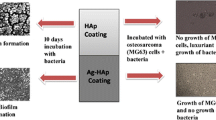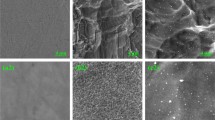Abstract
Microbial infection around dental implants is a major cause for the loss of devices, including soft tissue infection in early period, post-operation peri-implantitis, and osseointegration failure. Silver nanoparticles (AgNPs) with wide antimicrobial spectrum, strong antimicrobial effect and hypotoxicity, as well as low incidence of antibiotic resistance, are widely involved in biomedical applications. Herein, firmly anchoring AgNPs onto the surface of implants through physical-chemical reaction is likely to relieve the above issues. In this study, AgNPs were biosynthesized by a simple and “green” method with chitosan (CS) as stabilizing and reducing agents. Then, AgNPs-loaded CS-heparin polyelectrolyte multilayers (PEMs) were constructed on alkali-heat treated titanium (Ti) substrates via layer-by-layer (LbL) self-assembly technique. The successful surface modification could be confirmed by scanning electron microscopy (SEM) and X-ray photoelectron spectroscopy (XPS), and the constructed system could provide the continuous release of Ag+ over 28 days till mucosa healing. In short, this work revealed that the construction of multilayer coatings containing AgNPs on Ti substrates promoted adhesion and proliferation of human gingival fibroblasts (HGFs) and also enhanced the antimicrobial properties. This manifests the LbL technique is a viable and promising method for forming continuous antimicrobial coatings, to reduce microbial infection and improve the quality of peri-implant soft tissue seal.

The preparation process of AgNPs-loaded CS-heparin PEMs on Ti substrate.









Similar content being viewed by others
References
Liu M, Zhou J, Yang Y, Zheng M, Yang J, Tan J. Surface modification of zirconia with polydopamine to enhance fibroblast response and decrease bacterial activity in vitro: a potential technique for soft tissue engineering applications. Colloids Surf B Biointerfaces. 2015;136:74–83.
Jeong WS, Kwon JS, Choi EH, Kim KM. The effects of non-thermal atmospheric pressure plasma treated titanium surface on behaviors of oral soft tissue cells. Sci Rep. 2018;8:15963.
Orapiriyakul W, Young PS, Damiati L, Tsimbouri PM. Antibacterial surface modification of titanium implants in orthopaedics. J Tissue Eng. 2018;9:2041731418789838.
Brum RS, Monich PR, Fredel MC, Contri G, Ramoa S, Magini RS, et al. Polymer coatings based on sulfonated-poly-ether-ether-ketone films for implant dentistry applications. J Mater Sci Mater Med. 2018;29:132.
Wang Y, Zhang Y, Miron RJ. Health, maintenance, and recovery of soft tissues around implants. Clin Implant Dent Relat Res. 2016;18:618–34.
Zhou L, Lai Y, Huang W, Huang S, Xu Z, Chen J, et al. Biofunctionalization of microgroove titanium surfaces with an antimicrobial peptide to enhance their bactericidal activity and cytocompatibility. Colloids Surf B Biointerfaces. 2015;128:552–60.
Esfahanizadeh N, Motalebi S, Daneshparvar N, Akhoundi N, Bonakdar S. Morphology, proliferation, and gene expression of gingival fibroblasts on Laser-Lok, titanium, and zirconia surfaces. Lasers Med Sci. 2016;31:863–73.
Kumar Y, Jain V, Chauhan SS, Bharate V, Koli D, Kumar M. Influence of different forms and materials (zirconia or titanium) of abutments in peri-implant soft-tissue healing using matrix metalloproteinase-8: a randomized pilot study. J Prosthet Dent. 2017;118:475–80.
Noronha VT, Paula AJ, Durán G, Galembeck A, Cogo-Müller K, Franz-Montan M, et al. Silver nanoparticles in dentistry. Dent Mater. 2017;33:1110–26.
Yuan Z, Liu P, Hao Y, Ding Y, Cai K. Construction of Ag-incorporated coating on Ti substrates for inhibited bacterial growth and enhanced osteoblast response. Colloids Surf B Biointerfaces. 2018;171:597–605.
Wei D, Sun W, Qian W, Ye Y, Ma X. The synthesis of chitosan-based silver nanoparticles and their antibacterial activity. Carbohydr Res. 2009;344:2375–82.
Ryan C, Alcock E, Buttimer F, Schmidt M, Clarke D, Pemble M, et al. Synthesis and characterisation of cross-linked chitosan composites functionalised with silver and gold nanoparticles for antimicrobial applications. Sci Technol Adv Mater. 2017;18:528–40.
Ahmed TA, Aljaeid BM. Preparation, characterization, and potential application of chitosan, chitosan derivatives, and chitosan metal nanoparticles in pharmaceutical drug delivery. Drug Des Devel Ther. 2016;10:483–507.
Logithkumar R, Keshavnarayan A, Dhivya S, Chawla A, Saravanan S, Selvamurugan N. A review of chitosan and its derivatives in bone tissue engineering. Carbohydr Polym. 2016;151:172–88.
Park S, Han U, Choi D, Hong J. Layer-by-layer assembled polymeric thin films as prospective drug delivery carriers: design and applications. Biomater Res. 2018;22:29.
Richardson JJ, Björnmalm M, Caruso F. Technology-driven layer-by-layer assembly of nanofilms. Science. 2015;348:aaa2491.
Tran HV, Tran LD, Ba CT, Vu HD, Nguyen TN, Pham DG, et al. Synthesis, characterization, antibacterial and antiproliferative activities of monodisperse chitosan- based silver nanoparticles. Colloids Surf A Physicochem Eng Asp. 2010;360:32–40.
Liu M, Luo G, Wang Y, Xu R, Wang Y, He W, et al. Nano-silver-decorated microfibrous eggshell membrane: processing, cytotoxicity assessment and optimization, antibacterial activity and wound healing. Sci Rep. 2017;7:436.
Song W, Song X, Yang C, Gao S, Klausen LH, Zhang Y, et al. Chitosan/siRNA functionalized titanium surface via a layer-by-layer approach for in vitro sustained gene silencing and osteogenic promotion. Int J Nanomed. 2015;10:2335–46.
Gao A, Hang R, Huang X, Zhao L, Zhang X, Wang L, et al. The effects of titania nanotubes with embedded silver oxide nanoparticles on bacteria and osteoblasts. Biomaterials. 2014;35:4223–35.
Mei S, Wang H, Wang W, Tong L, Pan H, Ruan C, et al. Antibacterial effects and biocompatibility of titanium surfaces with graded silver incorporation in titania nanotubes. Biomaterials. 2014;35:4255–65.
Abdelrahim R, Badr N, Baroudi K. Effect of anodization and alkali-heat treatment on the bioactivity of titanium implant material (an in vitro study). J Int Soc Prev Community Dent. 2016;6:189–95.
Buser D, Janner SFM, Wittneben J, Bragger U, Ramseier CA, Salvi GE. 10‐year survival and success rates of 511 titanium implants with a sandblasted and acid‐etched surface: a retrospective study in 303 partially Edentulous patients. Clin Implant Dent Relat Res. 2012;14:839–51.
Chappuis V, Buser R, Bragger U, Bornstein MM, Salvi GE, Buser D. Long-term outcomes of dental implants with a titanium plasma-sprayed surface: a 20-year prospective case series study in partially Edentulous patients. Clin Implant Dent Relat Res. 2013;15:780–90.
Garcia B, Camacho F, Peñarrocha D, Tallarico M, Perez S, Canullo L. Influence of plasma cleaning procedure on the interaction between soft tissue and abutments: a randomized controlled histologic study. Clin Oral Implants Res. 2017;28:1269–77.
Xue B, He D, Gao S, Wang D, Yokoyama K, Wang L. Biosynthesis of silver nanoparticles by the fungus Arthroderma fulvum and its antifungal activity against genera of Candida, Aspergillus and Fusarium. Int J Nanomed. 2016;11:1899–906.
Azuma K, Izumi R, Osaki T, Ifuku S, Morimoto M, Saimoto H, et al. Chitin, chitosan, and its derivatives for wound healing: old and new materials. J Funct Biomater. 2015;6:104–42.
Zhang X, Liu Z, Shen W, Gurunathan S. Silver nanoparticles: synthesis, characterization, properties, applications, and therapeutic approaches. Int J Mol Sci. 2016;17:1534.
Agnihotri S, Mukherji S, Mukherji S. Immobilized silver nanoparticles enhance contact killing and show highest efficacy: elucidation of the mechanism of bactericidal action of silver. Nanoscale. 2013;5:7328–40.
Yu J, Wang A, Tang Z, Henry J, Lee BL, Zhu Y, et al. The effect of stromal cell-derived factor-1α/heparin coating of biodegradable vascular grafts on the recruitment of both endothelial and smooth muscle progenitor cells for accelerated regeneration. Biomaterials. 2012;33:8062–74.
Cataldi A, Gallorini M, Giulio MD, Guarnieri S, Mariggio MA, Traini T, et al. Adhesion of human gingival fibroblasts/Streptococcus mitis co-culture on the nanocomposite system Chitlac-nAg. J Mater Sci Mater Med. 2016;27:88.
Howling GI, Dettmar PW, Goddard PA, Hampson FC, Dornish M, Wood EJ. The effect of chitin and chitosan on the proliferation of human skin fibroblasts and keratinocytes in vitro. Biomaterials. 2001;22:2959–66.
Boucard N, Viton C, Agay D, Mari E, Roger T, Chancerelle Y, et al. The use of physical hydrogels of chitosan for skin regeneration following third-degree burns. Biomaterials. 2007;28:3478–88.
Alsarra IA. Chitosan topical gel formulation in the management of burn wounds. Int J Biol Macromol. 2009;45:16–21.
Lei K, Wang X, Li X, Wang L. The innovative fabrication and applications of carvacrol nanoemulsions, carboxymethyl chitosan microgels and their composite films. Colloids Surf B Biointerfaces. 2018;175:688–96.
Adeli H, Khorasani MT, Parvazinia M. Wound dressing based on electrospun PVA/chitosan/starch nanofibrous mats: fabrication, antibacterial and cytocompatibility evaluation and in vitro healing assay. Int J Biol Macromol. 2019;122:238–54.
Kumorek M, Kubies D, Filova E, Houska M, Kasoju N, Mazl Chanova E, et al. Cellular responses modulated by FGF-2 adsorbed on albumin/heparin layer-by-layer assemblies. PloS ONE. 2015;10:e0125484.
Frojd V, LEC DePaz, Andersson M, Wennerberg A, Davies JR, Svensater G. In situ analysis of multispecies biofilm formation on customized titanium surfaces. Mol Oral Microbiol. 2011;26:241–52.
Acknowledgements
This work was supported by the project of State Key Laboratory of Solid Lubrication, Lanzhou Institute of Chemical Physics, Chinese Academy of Sciences (No. LSL-1309), the National Natural Science Foundation of China (No. 81701029), the Natural Science Foundation of Gansu Province (Nos. 17JR5RA335 and 1606RJZA185), and the Autonomous Research Project of State Key Laboratory of Military Stomatology (No. 2016KB02).
Author information
Authors and Affiliations
Corresponding authors
Ethics declarations
Conflict of interest
The authors declare that they have no conflict of interest.
Additional information
Publisher’s note: Springer Nature remains neutral with regard to jurisdictional claims in published maps and institutional affiliations.
Rights and permissions
About this article
Cite this article
Li, W., Yang, Y., Zhang, H. et al. Improvements on biological and antimicrobial properties of titanium modified by AgNPs-loaded chitosan-heparin polyelectrolyte multilayers. J Mater Sci: Mater Med 30, 52 (2019). https://doi.org/10.1007/s10856-019-6250-x
Received:
Accepted:
Published:
DOI: https://doi.org/10.1007/s10856-019-6250-x




